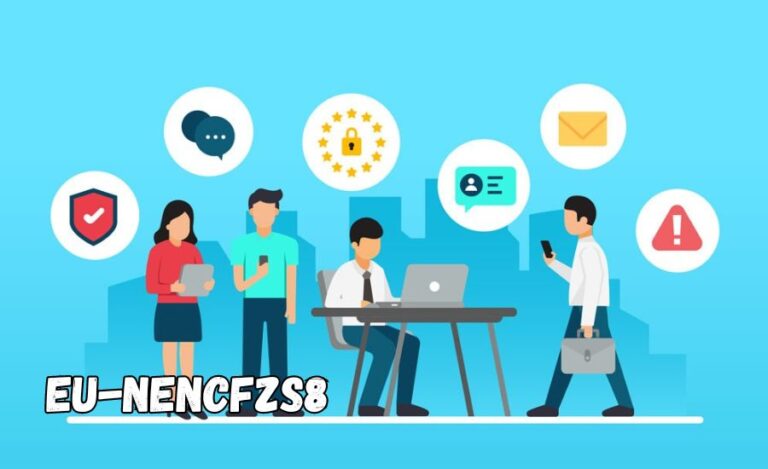In today’s fast-paced digital world, marketing strategies are always changing. As technology evolves, so do the methods we use to reach our audiences. One of the latest developments shaking up the digital marketing scene is the EU-NENCFZS8 framework. This innovative technology is not just another tool; it’s a game changer that can help businesses connect with customers in more effective and meaningful ways.
In this article, we’ll dive deep into EU-NENCFZS8. We’ll explore what it is, how it works, and why it matters for anyone involved in digital marketing. Our goal is to provide you with a thorough understanding of EU-NENCFZS8 and how it can shape the future of your marketing strategies.
Understanding EU-NENCFZS8
EU-NENCFZS8 is a regulatory framework developed by the European Union. Its main goal is to enhance transparency, accountability, and consumer protection in digital marketing. This framework addresses many aspects of marketing, including how companies collect and use consumer data.
Key Components of EU-NENCFZS8
The EU-NENCFZS8 framework is built on several key components:
- Data Protection: Companies must ensure that they collect personal data in a way that respects consumers’ privacy rights.
- Consumer Consent: Businesses need to obtain clear and explicit consent from consumers before collecting their data.
- Transparency in Marketing Communications: Marketers must provide clear information about how consumer data is used and give consumers easy options to opt out.
By following these guidelines, marketers can build trust with their audiences, which is crucial in today’s competitive landscape.
The Evolution of Digital Marketing
Digital marketing has come a long way from its early days. Let’s take a quick look at how it has evolved over the years.
Historical Perspective on Digital Marketing Strategies
In the beginning, digital marketing was simple. Companies used basic online ads and email campaigns to reach customers. These methods worked, but they often lacked engagement and personalization.
Traditional Methods vs. Modern Approaches
Traditional methods, such as static web banners and pay-per-click (PPC) ads, were common. However, as technology advanced, marketers began to realize the importance of data-driven insights. This shift allowed for more targeted marketing efforts, leading to better customer engagement.
Key Milestones in the Evolution of Digital Marketing
Several key milestones have shaped the digital marketing landscape:
- The Rise of Social Media: Platforms like Facebook and Instagram transformed how businesses connect with consumers.
- Search Engine Optimization (SEO): Businesses began focusing on optimizing their content to rank higher in search results.
- Content Marketing: Brands learned to tell their stories through engaging content, building stronger relationships with their audiences.
The Impact of EU-NENCFZS8 on Marketing Strategies

The introduction of EU-NENCFZS8 has had a significant impact on how marketers approach their strategies. Let’s explore some of the key changes it brings.
Data Collection and Consent Requirements
One of the most notable changes is the requirement for explicit consumer consent. Marketers can no longer rely on pre-checked boxes to gather consent. Instead, they must provide clear and straightforward options for consumers to agree to data collection.
Changes in Targeting and Segmentation Practices
With EU-NENCFZS8, marketers need to reevaluate their targeting strategies. They must ensure that their practices comply with the framework’s regulations. This may involve using compliant data sources and providing clear opt-out options for consumers.
Enhancing Transparency and Accountability in Marketing
Transparency is a cornerstone of EU-NENCFZS8. Marketers must be upfront about how they use consumer data and what information they collect. This transparency builds trust and fosters a positive relationship with consumers.
Technological Advancements Driven by EU-NENCFZS8
As EU-NENCFZS8 reshapes digital marketing, it also drives significant technological advancements. Let’s look at some of the key tools and innovations.
Overview of Technological Tools and Integrations
EU-NENCFZS8 supports advanced technologies that enhance data collection and analysis. Marketers can leverage these tools to create more effective campaigns.
The Role of AI and Machine Learning
Artificial intelligence (AI) and machine learning are at the forefront of this transformation. These technologies enable marketers to analyze consumer data in real time, allowing for quicker adjustments to marketing strategies.
Real-Time Data Processing and Its Benefits
The ability to process data in real-time means marketers can make informed decisions on the fly. This agility allows for more responsive and adaptive marketing strategies.
Practical Applications of EU-NENCFZS8
To truly understand the impact of EU NENCFZS8, it’s essential to look at how businesses are implementing it in real-world scenarios.
Case Studies of Successful Implementation
Let’s explore a few success stories:
- Retail Company Example: A retail company revamped its data collection methods to comply with EU-NENCFZS8. By implementing clear consent mechanisms, they saw a 30% increase in sales within six months.
- Tech Startup Success: A tech startup used EU-NENCFZS8 to improve its targeted email campaigns. This led to higher open rates and greater customer engagement.
Analysis of Strategies Used and Results Achieved
In these case studies, businesses demonstrated how EU NENCFZS8 could lead to tangible improvements. By focusing on compliant practices and leveraging data insights, they achieved better marketing outcomes.
Tips for Integrating EU-NENCFZS8
To effectively incorporate EU-NENC FZS8 into your marketing strategies, consider these tips:
- Conduct an Audit: Review your current marketing practices to identify areas for improvement.
- Prioritize Consent: Implement user-friendly consent mechanisms and opt-out options.
- Focus on Transparency: Communicate clearly with consumers about data usage and privacy.
Also Read: 04-01-01-2-dcfsa
Future Outlook of EU-NENCFZS8 and Digital Marketing

As digital marketing continues to evolve, so will EU-NENCFZS8. Let’s explore the long-term implications and future developments.
Predictions for the Evolution of EU-NENCFZS8
We can expect EU-NENCFZS8 to become even more integrated into various marketing platforms. As technology advances, the framework will likely evolve to address new challenges and opportunities.
Long-Term Implications for Digital Marketing
The focus on transparency and accountability will continue to shape marketing strategies. Businesses that adopt EU-NENCFZS8 early will be well-positioned to gain a competitive advantage.
Preparing for Future Developments
To stay ahead of the curve, marketers should prioritize ongoing education. Keeping up with the latest regulatory developments and seeking guidance from experts will be essential for success.
Conclusion
In conclusion, EU-NENCFZS8 represents a significant advancement in digital marketing technology. By understanding its implications and implementing compliant strategies, marketers can enhance transparency, build consumer trust, and achieve better outcomes.
As the digital marketing landscape evolves, staying informed and adaptable will be crucial. Embracing EU-NENCFZS8 will not only help businesses comply with regulations but also drive success in their marketing efforts.
For those looking to improve their marketing strategies, exploring and implementing EU-NENCFZS8 is a valuable step forward.
FAQs
Q: What is EU-NENCFZS8?
A: EU NENCFZS8 is a regulatory framework by the European Union aimed at enhancing transparency and consumer protection in digital marketing.
Q: How does EU-NENCFZS8 improve digital marketing?
A: It provides clear guidelines for data collection and usage, helping marketers build trust with their audiences.
Q: What are the critical features of EU-NENCFZS8?
A: Key features include explicit consumer consent, transparency in communications, and robust data protection measures.
Q: How can businesses integrate EU-NENCFZS8 into their marketing strategies?
A: By auditing current practices, prioritizing consent, and focusing on transparency in data usage.
Q: Are there success stories related to EU NENCFZS8?
A: Yes, many businesses have reported increased sales and customer engagement by successfully implementing EU NENCFZS8 guidelines.
Stay informed with the latest news and updates on Dallasinsiders.com
